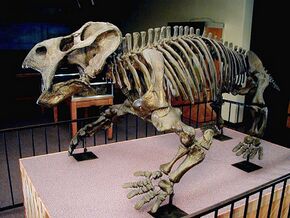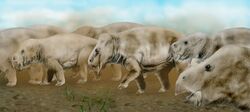Biology:Placerias
| Placerias | |
|---|---|

| |
| Skeleton | |
| Scientific classification | |
| Domain: | Eukaryota |
| Kingdom: | Animalia |
| Phylum: | Chordata |
| Clade: | Synapsida |
| Clade: | Therapsida |
| Suborder: | †Anomodontia |
| Clade: | †Dicynodontia |
| Family: | †Stahleckeriidae |
| Subfamily: | †Placeriinae |
| Genus: | †Placerias Lucas, 1904 |
| Species: | †P. hesternus
|
| Binomial name | |
| †Placerias hesternus Lucas, 1904
| |
Placerias (meaning 'broad body')[2] is an extinct genus of dicynodonts that lived during the Carnian to the Norian age of the Triassic Period (230–220 million years ago). Placerias belongs to a group of dicynodonts called Kannemeyeriiformes, which was the last known group of dicynodonts before the taxon became extinct at the end of the Triassic.
Description

Placerias was one of the largest herbivores in the Late Triassic, measuring 3.5 metres (11 ft) long and weighing up to 800–1,000 kilograms (1,800–2,200 lb).[3][4][5] The largest skull found had a length of 68 centimetres (26.8 in).[6] Placerias had a powerful neck, strong legs, and barrel-shaped body. There are possible ecological and evolutionary parallels with the modern hippopotamus, spending much of its time during the wet season wallowing in the water, chewing at bankside vegetation.[citation needed] Remaining in the water would also have given Placerias some protection against land-based predators such as Postosuchus.[citation needed] Placerias used its beak to slice through thick branches and roots with two short tusks that could be used for defence and for intra-specific display.[citation needed] Placerias was closely related to Ischigualastia and similar in appearance.[citation needed]
Discovery

Fossils of forty Placerias were found near St. Johns, southeast of the Petrified Forest in the Chinle Formation of Arizona. This site has become known as the 'Placerias Quarry' and was discovered in 1930, by Charles Camp and Samuel Welles, of the University of California, Berkeley. Sedimentological features of the site indicate a low-energy depositional environment, possibly flood-plain or overbank. Bones are associated mostly with mudstones and a layer that contains numerous carbonate nodules. It is also known from the Pekin Formation of North Carolina.[7]
Placerias was originally considered the last of the dicynodonts until fossil finds from Queensland were reported in 2003 to have revealed that the dicynodonts survived until the Early Cretaceous.[8] Agnolin et al. (2010) called for a reconsideration of that Australian specimen, noting its similarity to baurusuchian crocodyliforms such as Baurusuchus pachecoi.[9] The Cretaceous dicynodont specimen was eventually discovered to belong to a specimen of Diprotodon instead.[10] The giant dicynodont Lisowicia also survived into the late Triassic.[11]
See also
- List of therapsids
- Ischigualastia
References
- ↑ Kent, Dennis V.; Olsen, Paul E.; Lepre, Christopher; Rasmussen, Cornelia; Mundil, Roland; Gehrels, George E.; Giesler, Dominique; Irmis, Randall B. et al. (October 16, 2019). "Magnetochronology of the Entire Chinle Formation (Norian Age) in a Scientific Drill Core From Petrified Forest National Park (Arizona, USA) and Implications for Regional and Global Correlations in the Late Triassic". Geochemistry, Geophysics, Geosystems (American Geophysical Union) 20 (11): 4654–4664. doi:10.1029/2019GC008474. Bibcode: 2019GGG....20.4654K. https://geology.rutgers.edu/images/Kent20191.pdf.
- ↑ Paleofile. "Page on Placerias". http://www.paleofile.com/Demo/Taxa/Placerias.htm.
- ↑ Prothero, Donald R. (18 April 2022). "20. Synapsids: The Origin of Mammals" (in en). Vertebrate Evolution: From Origins to Dinosaurs and Beyond. Boca Raton: CRC Press. doi:10.1201/9781003128205-4. ISBN 978-0-36-747316-7.
- ↑ Hartman, Scott A.; Lovelace, David M.; Linzmeier, Benjamin J.; Mathewson, Paul D.; Porter, Warren P. (November 2022). "Mechanistic Thermal Modeling of Late Triassic Terrestrial Amniotes Predicts Biogeographic Distribution" (in en). Diversity 14 (11): 973. doi:10.3390/d14110973. ISSN 1424-2818.
- ↑ Fiorillo, Anthony R.; Padian, Kevin; Musikasinthorn, Chayanin (2000). "Taphonomy and Depositional Setting of the Placerias Quarry (Chinle Formation: Late Triassic, Arizona)". PALAIOS 15 (5): 373–386. doi:10.2307/3515510. ISSN 0883-1351. https://www.jstor.org/stable/3515510.
- ↑ Green, Jeremy; Schneider, Vince; Schweitzer, Mary; Clarke, Julia (2005-09-07). "NEW EVIDENCE FOR NON-PLACERIAS DICYNODONTS IN THE LATE TRIASSIC (CARNIAN-NORIAN) OF NORTH AMERICA". Journal of Vertebrate Paleontology 25: 65A–66A. https://www.researchgate.net/publication/296314713.
- ↑ "Fossilworks: Placerias hesternus". http://www.fossilworks.org/cgi-bin/bridge.pl?a=taxonInfo&taxon_no=155546.
- ↑ Thulborn, T.; Turner, S. (2003). "The last dicynodont: an Australian Cretaceous relic". Proceedings of the Royal Society of London B 270 (1518): 985–993. doi:10.1098/rspb.2002.2296. PMID 12803915.
- ↑ Agnolin, F. L.; Ezcurra, M. D.; Pais, D. F.; Salisbury, S. W. (2010). "A reappraisal of the Cretaceous non-avian dinosaur faunas from Australia and New Zealand: Evidence for their Gondwanan affinities". Journal of Systematic Palaeontology 8 (2): 257–300. doi:10.1080/14772011003594870.
- ↑ Knutsen, Espen M.; Oerlemans, Emma (January 2020). "The last dicynodont? Re-assessing the taxonomic and temporal relationships of a contentious Australian fossil". Gondwana Research 77: 184–203. doi:10.1016/j.gr.2019.07.011. Bibcode: 2020GondR..77..184K.
- ↑ Racki, Grzegorz; Lucas, Spencer G. (2020-04-20). "Timing of dicynodont extinction in light of an unusual Late Triassic Polish fauna and Cuvier's approach to extinction". Historical Biology 32 (4): 452–461. doi:10.1080/08912963.2018.1499734. ISSN 0891-2963. https://doi.org/10.1080/08912963.2018.1499734.
External links
- Walking with Dinosaurs – Fact File: Placerias
- Dinosaur and Paleontology Dictionary: Placerias
- Walking with Dinosaurs website
Wikidata ☰ Q131275 entry
 |

